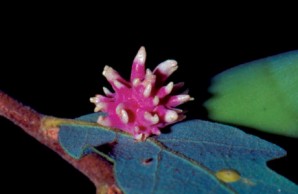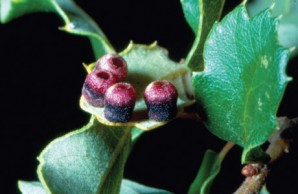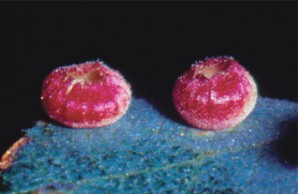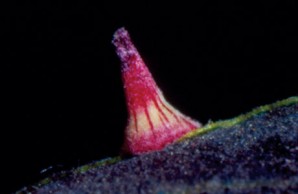By Ron Russo Natural History Magazine, Dec 2009-Jan 2010 http://www.naturalhistorymag.com/features/231962/confessions-of-a-gall-hunter
| Back in 1969, while I was working as a naturalist for the East Bay Regional Park District in Oakland, California, my boss, Chris Nelson, dropped a bunch of purple spiny things on my desk. “What are they?” he wanted to know. Well, I might have said they were miniature purple sea urchins, except that those strange objects were attached to the leaves of a blue oak, Quercus douglasii. Was he playing some sort of botanical prank on me? At that nascent stage in my career I aspired to pursue research on a grand scale, involving, say, entire forest ecosystems. But with his simple (and innocent) action, Nelson had sparked my curiosity about something small and wonderful, helping to define the course of my life. |  Urchin gall was the first kind of gall that the author encountered. The gall pictured, growing on the underside of a leaf of blue oak, provides shelter and nutrition for a larva of the urchin gall wasp, Antron quercusechinus. (Ron Russo photograph) |
The search for a better understanding of those natural “plant urchins” quickly led me to the late Sara S. Rosenthal, then a young wasp biologist from the University of California’s Essig Museum of Entomology at Berkeley. Together we visited an old blue oak in Briones Regional Park, in the hills above Martinez, California. In the space of an hour or so, she pointed out twenty-one structures of every imaginable shape and color on the leaves and stems of that single tree. They were galls, casings built by the tree in response to the manipulation of insects—in this instance, all species of wasps belonging to the family Cynipidae. Each cynipid species had made a distinct gall (you can identify the species of wasp by the shape, size, and color of the gall). One type of gall matched the purple bumps I had seen earlier: it was the product of the urchin gall wasp, Antron quercusechinus. I was nearly speechless. Living inside all those different kinds of galls were insects, some barely visible to the naked eye—but their homes were now so obvious! In all the time I had spent in woodland and forest habitat, how could I not have noticed them before?
Oak apple galls, produced by the wasp Trichoteras vaccinifoliae on huckleberry oak, measure about two inches in diameter and are often mistaken for fruit. (Photo by Ron Russo) |
Plant galls are tumorlike swellings initiated mostly by insects, but also by mistletoe and by some bacteria, fungi, and mites. With around a million species of insects known worldwide, their inventive feeding choices know no bounds: carrion, dung, pollen, fungi, leaves, nectar, sap, and blood, for starters. But only 13,000 species have evolved the ability to induce galls in specific host plants, thus co-opting the plants’ resources. Overshadowed by more dramatic species—ants, honeybees, disease-bearing mosquitoes, butterflies, and crop-damaging caterpillars—gall insects exist in our midst with little fanfare or publicity. They rarely have any economic or agricultural impact, despite their large numbers and widespread ranges. But they leave behind clues to their existence as distinctive as mountain lion tracks imprinted in the mud or an eagle feather fallen by a lakeshore. The diversity of those gall insects and their bizarre biology have fascinated me for forty years. |
I have focused on cynipid wasps. They provided my introduction to galls, and they also have an interesting claim to fame: Alfred C. Kinsey (prior to embarking on his controversial work on human sexuality in the 1930s) described many new species and varieties of cynipids. But those are not the main reasons I have stuck with them for so long. Instead, the approximately 1,400 species of cynipids intrigue me because theirs are among the most extravagant galls, assuming the shapes of sea urchins, stars, baskets, bowls, clubs, horns, and coral, to name just a few, in endless color combinations.
Cynipids rely primarily on oaks, sycamores, and certain members of the rose family as their hosts. Most of those wasps are quite small, some the size of a comma on this page, while others are about the size of a housefly. They are lilliputian architects, masters of grand alien designs, keepers of biological secrets that have defied naturalists and scientists since Hippocrates wrote about galls’ medicinal properties nearly 2,400 years ago.
A shell of plant tissue forms around each cynipid egg soon after it is deposited. However, the gall doesn’t really begin to grow around the shell—or group of shells—until after the hungry larvae hatch and begin feeding. Through their chewing, the wasp larvae release complex compounds that redirect the growth of different plant tissues to form the protective outer structures of the gall, its larval chamber, and its inner nutritive lining. While all cynipid nurseries have similar amenities on the inside, the gall’s outward shape, color, and size is unique to each species. Galls form on every plant organ—including roots, flowers, and fruits—but most seem to appear on twigs and leaves, where high metabolic activity occurs over a short period of time, particularly in the spring.
| After several months or more of development in those larval nurseries, the adult wasps emerge to live for about a week. During that time they generally fly short distances to locate a host, reproduce, deposit eggs, and start the cycle again. In many North American cynipid species there is a spring generation, with the galls developing in March and April and issuing adults by May or June. Those adults initiate a second, summer–fall generation that develops between July and October, with galls that look totally different from the spring galls. The adults from those summer–fall galls sometimes emerge in the fall, or, more commonly, in the early spring of the following year. |  |
Cynipid wasps that induce galls on oaks and sycamores are unique, however, in that many of them alternate between sexual and asexual reproduction. That is, one generation, born in spring, will be “bisexual” (meaning that it includes both males and females), and the next generation, born in summer or fall, will be all females. Those latter females reproduce parthenogenetically, without the aid of male genes, essentially creating clones of themselves—though some lay eggs that result in male “clones.” Some species are exclusively parthenogenetic: they produce only a single generation per year, with no males known in the population. That’s the case with Andricus quercuscalifornicus, which induces the largest insect gall in the western United States, approximately the size and shape of a baking potato.
Adult cynipid wasps don’t always complete their reproductive journey. Many are eaten, sometimes immediately upon emergence, by spiders, lizards, and such birds as kinglets, vireos, chickadees, and nuthatches. And even larvae, in the relative safety of the gall, fall prey to numerous parasitoids and inquilines. Parasitoids live in or on the larvae, ultimately killing them; I am reminded of one species in which every gall I examined in the field had been parasitized. Inquilines are specialized moths, weevils, beetles, wasps, and other insects that feed on gall tissue. While they are vegetarian by nature, many inquilines will destroy any larvae they contact while foraging. In spite of the hazards, from season to season enough gall wasps survive to continue their species. I once found a valley oak, Q. lobata, whose every leaf seemed to have dozens of saucer galls, made by the wasp Andricus gigas—perhaps tens of thousands of galls on that single looming tree. Their long-term survival certainly didn’t seem to be a problem.
Although certain galls are common, others are elusive. In one frustrating case, I have been hunting for the galls of Paracraspis insolens, a wasp whose tubular leaf gall was first recorded in 1926. Even though I have examined thousands of its hosts—canyon live oaks, Q. chrysolepis—over the course of several years, I have yet to find a single specimen. Is the wasp’s range extraordinarily restricted? Is it in a downswing of its population cycle? I don’t know. I have hunted at least half a dozen such elusive species for years. Every time I drive through woodland with canyon live oak, my imagination starts racing until I can’t stand it any longer: the species I have long sought could easily be hidden in one of those trees. I’ll stop and sometimes spend hours in each grove, searching every leaf within reach until I am exhausted.
I have been tracking different gall wasp species through much of the western U.S., and am currently compiling a survey of the distributions and population levels of several. I record the timing of the appearance of galls and the emergence of adults, and I also rear the wasps to adulthood in the laboratory. Such observations help to clarify the behavior of known as well as new species. Whenever I find a new species, I rely on taxonomist colleagues to assign the genus name, where possible. Occasionally I find an insect that doesn’t fit any known classification, as happened recently with a strange midge I reared from a bristly tube gall on catclaw, Acacia greggii. I will need several more adults before the species can be named.
Perhaps the trickiest part of the hunt for cynipids is to collect galls at the right time to rear the larvae to adulthood for identification purposes. With gall midges in the family Cecidomyiidae, generic determinations can be made using preserved larvae. But with cynipids and moths, adults are necessary for a definitive identification. If galls are collected too early, before the larvae have completed their development, chances of rearing adults are slim. If galls are collected closer to or after completion of larval development, then there is a greater chance adults will emerge later in the laboratory. Knowing exactly when to collect varies with each species and region. Sometimes the trick is just being systematic. For example, late one April I collected several bright green, melonlike leaf galls from Muller’s oak, Q. cornelius-mulleri, in the southern Mojave Desert. I had never seen galls of that type before, and was unsure of their stage of development. Nevertheless, hopeful that the month for collecting them might be right, I put the galls in a specimen jar. Two days later, while on the way home in my warm car, the adults emerged—safe in the container. Had I not been careful, I might have lost them in the car or out an open window. That species still awaits classification.
| One long-standing challenge that haunts me has involved several attempts at rearing adults from galls first recorded more than fifty years ago, in a book by Lewis H. Weld entitled Cynipid Galls of the Pacific Slope. Weld depicted a vein gall that he had found on the leaves of canyon live oak, Q. chrysolepis. He had failed to rear the adults, however, so he left the adult wasp as “undescribed”—and so it has remained. With several canyon live oaks on my property in Mount Shasta, California, and an abundance of those galls, I decided to solve the puzzle. Easier said than done! |  |
The egg of that wasp is laid directly into a leaf’s vein, usually at the leaf margin. The vein is essentially extruded out of the leaf and enlarged at its tip to form a gall, which thus enjoys a direct “main line” of nourishment into the larval chamber. The purple, clublike galls begin development in June or July. Although I have collected specimens for rearing in September, October, November, February, March, and May, I have had no results to date. I have found several galls in the field with small exit holes bored in the center, so something most likely came out. But when and under what circumstances the adults emerge, no one yet knows. That species may simply remain undescribed for several more years.
Another mystery has involved the paper gall wasp, Trichoteras vaccinifoliae, originally described in 1896. It induces paper-thin, hollow galls in the buds of canyon live oak in the summer. To date, no one has found or described an alternate generation. Every summer a tree on my property produces dozens of that wasp’s galls. Last spring, for the first time, I found a tiny new pyramidal leaf gall on that same tree in March and April, with adults emerging in May. Shortly thereafter, the galls of T. vaccinifoliae began to appear. Since no other galls appear in similar sequence on that tree, circumstantial evidence suggests that the spring leaf galls might belong to the bisexual generation of T. vaccinifoliae. Now that I have adults from both galls, I hope that morphological studies will help clarify their relationship.
Years ago I discovered a previously undescribed gall that I dubbed the “pink bow tie gall” on scrub oak, Q. berberidifolia. It was the work of an unknown species of wasp. For six years I frequented the host trees, always late in the summer. Then, to monitor development of the galls, I finally visited the trees in early summer and then came back at regular two-week intervals. At first I saw flat pink disks. Those disks morphed over the summer into the bow-tie shape with which I was familiar. It seems that while larvae are feeding, the disks remain flat. Once they stop feeding, the edges of the galls pinch inward, creating the bow-tie look by late summer or early fall.
California is a great laboratory for cynipid wasp research, with at least eighteen species of host oaks (about 4 percent of the world’s oak species) and several recognized varieties. There is an even richer diversity of gall wasps. In fact, it has been reported that California has more recognized cynipid species than North Africa, Europe, and Asia combined. In his book, Weld listed more than a hundred scientifically named species in California, and another hundred undescribed species. Since then, scientists have successfully connected the two alternating generations of many single species through rearing and morphological studies, thus eliminating some erroneous taxa.
In the U.S. as a whole, about 800 species of cynipids are scientifically named from oaks, roses, and a few miscellaneous host plants. The actual number of species out there is likely much higher. That thought keeps teasing and pushing me into virgin stands of oaks that I have not examined.
| A 2005 report from the University of California, Davis, estimated that about 30,000 acres of oak woodland are lost each year in California owing to development. Even as I help to clarify the biology of some known and new species of wasps, so much about the ecological role of oaks remains just beyond our grasp. That adds a sense of urgency to documenting the diversity of species in oak woodland environments. A single blue oak on a dry foothill slope can be a universe unto itself, with all sorts of predators, prey, and other beneficiaries, including birds, squirrels, and deer—more wildlife associates than any other kind of tree I am familiar with. |  Striped volcano gall, about one-quarter inch in height, on a blue oak leaf harbors a larva of the wasp Andricus atrimentus. Photo by Ron Russo |
Moreover, from what I have seen, I believe that the white oaks of the western U.S., and particularly the blue and valley oaks of the Central Valley and foothills of California, sport some of the most colorful, exotic, and oddly shaped galls found anywhere in the world. The urchin galls that I originally saw in 1969 remain among the most flamboyant of all. Yet they represent only the “tip of the gall-berg,” with those of the spined turban gall wasp (Antron douglasii), the crystalline tube gall wasp (Trichoteras tubifaciens), the sunburst gall wasp (Andricus stellaris), the saucer gall wasp (A. gigas), and the striped volcano gall wasp (A. atrimentus)—and others yet to be discovered—pushing the edge of the envelope of our imagination even further.
The exact mechanisms that lead to species-specific galls remain unknown. As some have suggested, that may be the Holy Grail of entomology. How are the blue oak’s leaf cells, for example, being manipulated by the secretions of A. quercusechinus to consistently result in galls of the same size, shape, and color? Are the plant’s genes being permanently altered? Several researchers in North America and Europe are working hard to understand the complexities of those relationships. The potential applications, in medicine and agriculture, for example, would be intriguing, to say the least.
But the thrill of discovery is what really keeps me in the field. Recently, my wife and I hiked up a heart-pounding 18-percent-grade trail for a mile into the Owen’s Peak Wilderness on the eastern side of the Sierra Nevada Mountains. We were looking for a small group of Palmer’s oaks, Q. palmeri, a shrubby species whose gall associates were relatively unknown. We found only three of the trees growing amid what must be tens of thousands of juniper, cactus, and various desert shrubs—three island specks in an ocean of treeless desert.
An intense two hours of searching paid off: the trees yielded three new species of cynipid galls! How did the wasps find those isolated hosts? For several minutes at the top of the ridge we pondered the evolutionary pairing of plant and insect, and the strange circumstances of their being together. Even though we were exhausted from the climb, the hunt—part of an ongoing quest, more than forty years in the making—was worth every step.
Related links:
“Galls on Plants” (Cornell University)
“Galls on Oak” (Pennsylvania State University)
“About Insect Galls” (Brandeis University)
“To Be or Not to Be a Gall” (Palomar College)
“Nature Trivia: Plant Galls” (Henderson State University)
“Insect and Mite Galls” (University of Minnesota)
“Insect Galls” (University Of Florida)
Wasp Galls on California Oaks (Poster PDF, photos by Ron Russo)
California Oak Foundation
Field Guide to Plant Galls of California and Other Western States, by Ron Russo (University of California Press)
British Plant Gall Society
Rancho Hondo Insects |